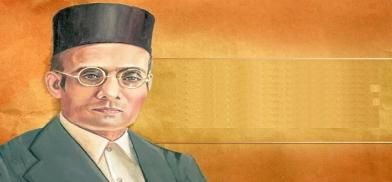When artistic freedom becomes a propaganda tool: Film on Hindu rightwing icon Veer Savarkar distorts history
In response to the teaser of the film, Netaji's daughter Anita Pfaff told the Times of India, "Like Mahatma Gandhi, Netaji was opposed to the divisiveness based on religious differences. Let Sarvarkar's followers join Netaji in his vision for India and not hijack him for views that certainly were not his."

Currently, as the rightwing wing ideology is gaining ground in India many a film have already come to promote divisiveness, to glorify the icons of communal nationalism, or to demonize particular communities. In recent times we have seen films on these lines, be it 'Padmavat', ‘Gandhi Virudh Godse’, ‘Kashmir Files’ and ‘Kerala Story’ and some other historical films. Many of these in the name of artistic freedom are total propaganda films and some of them are very vulgar too. Filmmakers are rushing to this genre of films as some of them are ideologically oriented in the rightwing ideology, while others are assured of good moolah as those who matter in current political dispensation are out to promote these films for their political goals.
In this chain one new film, ‘Swatantraveer Savakar'’s teaser was released to time with his 140th birth anniversary on 28th May when the new parliament building was also inaugurated. The 73-second teaser makes some statements and all of them are either false or manipulated to glorify Vinayak Damodar Savarkar, the patron saint of Hindu nationalism. Though he was not part of RSS, it was his book ‘Hindutva or Who is a Hindu’ which formed the ideological base of RSS. As RSS did not participate in the freedom struggle, it has been constructing icons which it thinks can be ideologically close to its political agenda. Savarkar is their major choice as in the first part of his life till he was jailed in the Andaman islands and was an anti-British revolutionary. Harping on this part of his life the Hindu nationalists glorify him to the sky.
When Atal Bihari Vajpayee led NDA came to power in 1998, Savarkar’s portrait was unveiled in parliament. The debate around unveiling of his portrait also projected the second part of his life when he emerged as the ideologue of Hindu nationalism, ‘two nation theory’ and his collaboration with British rule.
During his regime Vajpayee planned to give Bharat Ratna, India's highest civilian honour, to Savarkar, but this proposal was turned down by the then President of India, Dr. K.R. Narayanan. That notwithstanding a plaque was put up in his honor in Andamans. Now during the last nine years of the Hindu nationalist BJP-led government, Savarkar's anniversary is celebrated with pomp and the latest in the series of honoring him was to inaugurate the new parliament building on his birthday.
Belittling Gandhi's non-violence
The tease states that only few people participated in the anti British struggle and the rest were there to grab power. This is a big insult to all those revolutionaries who, unlike Savarkar, rotted and died in Andaman jail, to all those Indians who participated in the major anti British movements of 1920 (Non Cooperation), the Civil disobedience (1930), Dandi March, the Quit India. It is also an insult to the likes of Bhagat Singh, Chandrasekhar Azad and their colleagues who in the bravest possible fashion put their lives on their palms and stood rock solid against the British Empire. It is an insult to the efforts of Netaji’s Azad Hind Fauj, the Singapore-based Indian National Army.
Teaser goes on to state that had Gandhi not insisted on non violence India would have got freedom 35 years ago, i.e. in 1912. The script writer must have been in the world of unadulterated fiction to have written this. In 1912, Savarkar himself was in Andamans, Bal Gangadhar Tilak, the major leader of Congress, was in Mandalay prison and Gandhi was in South Africa. That the major role in the freedom of the country was played by non-violence is stating the obvious. The revolutionaries like Bhagat Singh, in later part of their movement, opined that non violent mass movement is the path for getting freedom.
The teaser claims that it was Savarkar, who was the source of inspiration for Khudiram Bose, Bhagat Singh and Netaji Subhas Chandra Bose. Lies should have their limits but not for those who are motivated ideologically especially in sectarian nationalism. Eighteen-year-old Khudiram Bose was martyred in 1908, a year before Savarkar’s book on 1857 came to light, while Savarakr himself was in London from 1906 to 1911. As far as Bhagat Singh is concerned he did mention Savarakr’s book on 1857 and ‘Hindu Padpadshi’ among many other books, not as a source of inspiration but for some quotes. Bhagat Singh was inspired by Gadar party’s Kartar Sarabha, whose photo he used to carry in his pocket. And also by Lenin, whose literature he devoured through and through.
Bhagat Singh was a total contrast to Savarkar. Savarkar pleaded for clemency, offering to serve the British in whatever way they thought fit. He did help strengthen their army in the context of the Second World War and was a recipient of a British pension of 60 rupees per month. Savarkar did not utter a single word when Bhagat Singh was hanged to death.
Netaji stood for composite nationalism
As far as Netaji Bose, the rumor is spread through multiple mechanisms, that it was on Savakar’s advice that he formed Azad Hind Fauj. There is no truth in this. Savarakar actually was helping the British army when Bose’s army was fighting against the British. Bose was for composite nationalism, while Savarkar was the ideologue of religion based nationalism, two nation theory. Bose was equally critical of Savarakar and Jinnah whom he urged to close ranks and join the freedom movement, while this duo served the British designs of suppressing the national movement.
In his article in The Forward Bloc (his paper) Bose argued that ‘The Hindu Mahasabha has been doing incalculable harm to the idea of Indian nationhood by underlining the communal differences—by lumping all the Muslims together...We cannot oblige Mr Savarkar by ignoring the contributions of the nationalist Muslims to the cause of India.’
He wrote in the second part of his book, The Indian Struggle, that while Jinnah ‘was then thinking only of how to realise his plan of Pakistan (the division of India) with the help of the British,’ Savarkar seemed to be oblivious of the international situation and was only thinking how the Hindus could secure military training by entering Britain’s army in India.’
In response to the teaser of the film, Netaji's daughter Anita Pfaff told the Times of India, "Like Mahatma Gandhi, Netaji was opposed to the divisiveness based on religious differences. Let Sarvarkar's followers join Netaji in his vision for India and not hijack him for views that certainly were not his."
We are living in times where the Hindu rightwing is being well served by many in the film world, and this forthcoming film based on falsehoods will be one more example of the same.
(The writer, a former IIT Bombay professor, is Chairman of, Centre for Study of Society and Secularism, Mumbai. Views are personal.)
Здесь доступны новости о политике, технологиях и многом другом.
Контент пополняется почти без перерывов, что позволяет держать руку на пульсе.
Удобная структура облегчает восприятие.
https://km-moda.ru
Каждая статья предлагаются с фактчеком.
Редакция придерживается объективности.
Читайте нас регулярно, чтобы быть всегда информированными.
Здесь можно найти новости о политике, науке и многом другом.
Контент пополняется в режиме реального времени, что позволяет не пропустить важное.
Простой интерфейс ускоряет поиск.
https://podium24.ru
Каждое сообщение проходят проверку.
Редакция придерживается честной подачи.
Присоединяйтесь к читателям, чтобы быть в центре внимания.
Our company delivers tailored solutions for enterprises of any size.
We take care of all logistics processes to make your workflow smooth.
<a href="https://asia-cargo.site/">air delivery from china</a>
With regular shipments, we secure timely delivery of your consignments.
Clients trust our skilled team and affordable rates.
Choosing us means certainty in every order.
Они предпочитают к осознанному подходу в жизни.
Такие девушки часто обладают четким характером и сформированными жизненными приоритетами.
Они не боятся артикулировать свои убеждения.
https://rostov.spaxam.net/
Взаимодействие с ними нередко получается интересным.
Они стремятся понимать собеседника и формировать настоящие отношения.
Такие девушки влияют окружающих своей подлинностью.
Они стремятся своим маршрутом, не подстраиваясь под сторонние ожидания.










Post a Comment